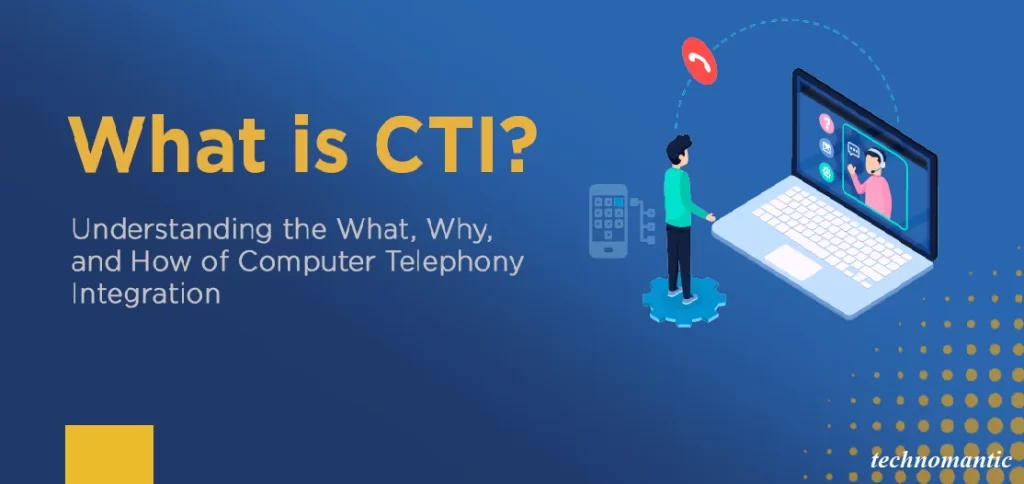Computer telephony integration is the process of integrating a call agent’s desktop with the company phone system. All businesses answer both internal and external phone calls. They may handle these calls internally or outsource to a call center, depending on the volume of calls they receive.
CTI, or computer telephony integration, streamlines call processing and collects data for future development. CTI software is usually used by call centers to optimize their workflow.
In this article, we’ll discuss Computer Telephony Integration CTI including what it is, how it works, and which CTI software is the best in the market.
Must Read: Understanding The Various Benefits Of Proposal Automation
Unraveling the Concept: What is Computer Telephony Integration (CTI)?

The process of connecting a call center’s phone systems to its business applications is known as Computer Telephony Integration (CTI.) This is usually done so that the business application has more control over call handling. Agents can conduct all phone operations on their computers utilizing on-screen controls for telephony services.
These operations such as taking and dropping calls, placing callers on hold, transferring calls, etc., with computer telephony integration (CTI), eliminate the need for an actual phone.
Additionally, these features can boost an organization’s productivity and enhance the customer experience. Companies that take advantage of CTI capabilities are always at the forefront because they can provide real-time customer assistance.
For example, customer service agents can examine customer information and previous correspondence history as soon as they answer a call. This level of planning can greatly enhance communication, which will make it simpler to satisfy clients and drive business improvement.
How Computer Telephony Integration (CTI) Works?
Computer Telephony Integration works by giving the phone controls to the agent interface. It also enables integration with other company systems, such as customer relationship management CRM, video conferencing, team communication, knowledge, and product database.
Implementation of Computer Telephony Integration – Innovative Approaches and Techniques

If you are thinking about the implementation of CTI in your business, it is critical to recognize the diverse techniques and strategies available. Firstly, server-primarily based CTI implementation involves the setup of a CTI server that connects your business’s smartphone gadget with your PC network.
Another method is the PC-based implementation, in which a modem or special telephony card is attached to the agency’s computer. This allows the computer to interact directly with the phone machine, eliminating the need for a dedicated CTI server.
Third-party call control is a more advanced approach that lets outside software control conversations among the commercial enterprise’s PC and phone systems. This can provide extra flexibility and control over the integration process.
Regardless of the implementation approach you select, it’s vital to work with an experienced IT professional. These experts can correctly navigate the complexities of deploying CTI even ensuring minimal disruption for your contemporary workflow.
Advantages of Computer Telephony Integration (CTI)
There are numerous advantages to call center automation with computer telephony integration software for your company. Here are some of them:
- Establishment of standardized procedures for handling calls
- Cut back on call center expenses
- Help in handling routine tasks efficiently
- Significant increase in the agents’ productivity
- Great improvement in the customer experience and satisfaction
Applications of Computer Telephony Integration (CTI)
CTI technology advances the telephone’s capability beyond making and receiving calls. One key characteristic of this technology is automatic call routing. It allows businesses to prioritize and direct incoming calls to appropriate retailers or departments.
Another crucial capability of CTI is the customer data screen pops. With this option, client statistics are displayed as soon as a call is hooked up. It imparts the agent with sufficient context of the purchaser’s records with the business enterprise.
CTI is likewise equipped with interactive voice reaction (IVR) systems. It guides callers through one-of-a-kind alternatives before connecting them to the right branch or representative. This could have a considerable effect on reducing wait times and enhancing consumer satisfaction.
One of the greater recent trends in CTI is the advent of computer telephony integration with customer relationship management (CRM) software programs. This integration lets users leverage the capabilities of each system, further improving caller reviews and improving business efficiency.
How Call Centers Can Use CTI Technology?
CTI assists with call center operations in the following ways:
- When the phone rings, contextual information about the caller is displayed. Another name for this feature is screen popping.
- Implement interactive voice response (IVR) technology. It allows customers to self-service which optimizes agent time utilization.
- Put the call records in the CRM.
- Trigger corporate apps in response to caller or agent needs.
- Use caller history or IVR selections to determine call routing, transfer, and forwarding to the appropriate agent.
How to Find the Best Computer Telephony Integration (CTI) Software?
With the use of computer telephony integration software, you may create standardized call center procedures, monitor compliance, collect data, and derive insightful knowledge.
Numerous CTI platforms and software are available in the market. Some of the best among them are LiveAgent, Freshdesk Contact Centre, Twilio Flex, Zendesk Talk, and more.
It is important to be clear about the features you require from the CTI software, both essential and desirable before you begin the process of selecting the appropriate program.
Final Words
Computer telephony integration encompasses more than just connecting your phone systems to the calling agent’s desktop. It all comes down to how you want to handle calls internally, the kind of experience you want to give your callers, and how successfully you can use data to expand your company.




